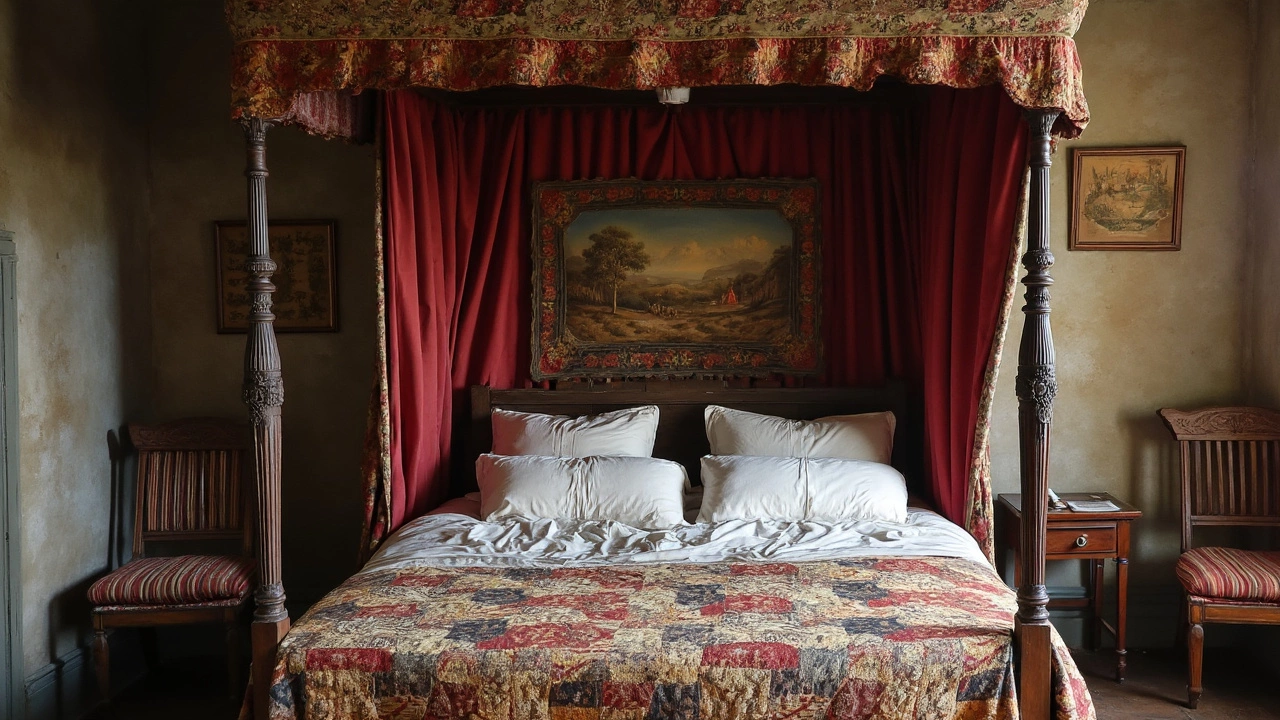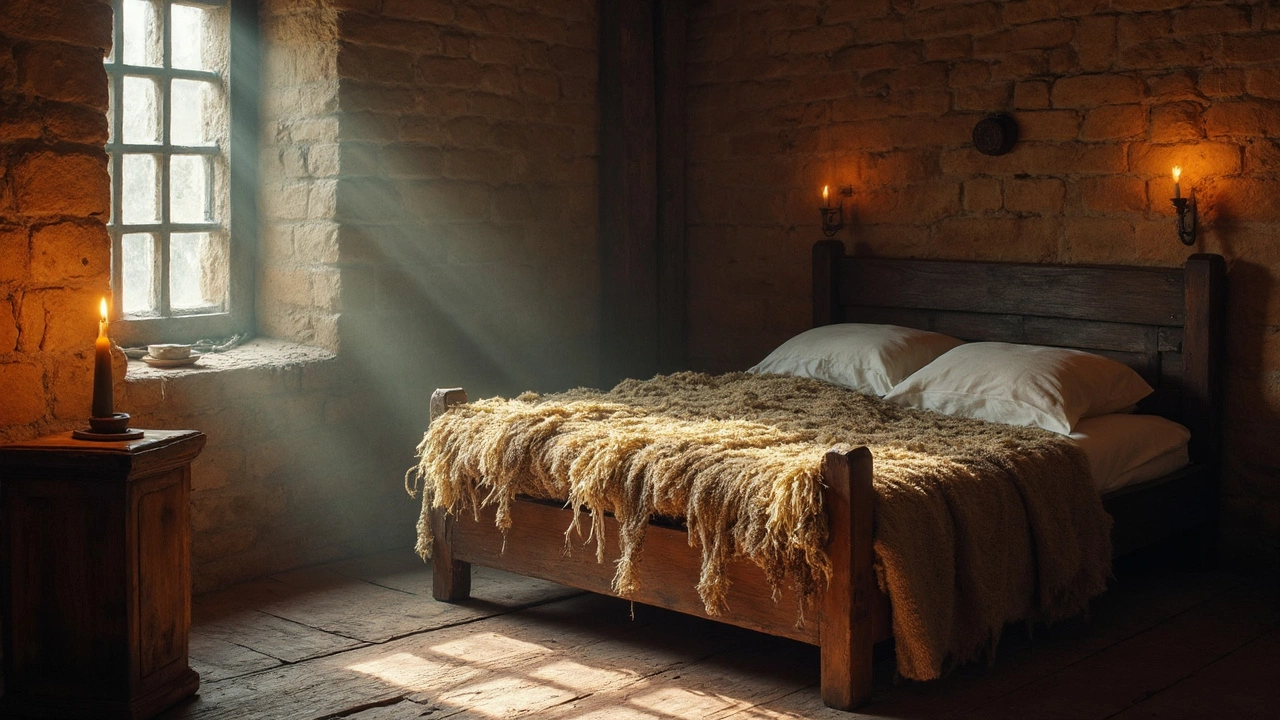Bedding today is all about cozy blankets and fluffy pillows, right? But rewind a couple of centuries, and you'd see a totally different picture. Originally, 'bedding' meant something much broader than we think of now. Back then, bedding often referred to everything you needed for a good night's sleep—from a bed frame, if you were lucky, to a pile of straw for the less fortunate.
So why straw, you ask? Well, before the days of memory foam and Egyptian cotton, people had to get creative with what was available. Straw was cheap, easy to replace, and offered some cushioning. Plus, it was great for insulation during those chilly nights.
It's fascinating to think that bedding wasn't just about personal comfort but had practical uses too. In areas with cold climates, layers of animal skins would be added. In warmer regions, thinner fabrics were more common. This balance between functionality and need formed the bedding practices we know today.
- Historical Significance of Bedding
- Materials Used in Old Bedding
- Bedding in Different Cultures
- Evolution of Bedding Over Time
Historical Significance of Bedding
Bedding has a much richer history than we might give it credit for. It wasn't always about style and comfort. Way back when, bedding history was about survival, protection, and even social status. Can you believe that some of the earliest forms of bedding were just heaps of leaves or straw? Cozy, right?
Way before the advent of today's adorable duvet sets, ancient Egyptians crafted their beds from materials like stone and wood. Talk about firm support! But it wasn't just about a good night's rest. Bedding in ancient civilizations often signified one's wealth and social standing. The richer you were, the more elaborate your bed. Kings and queens wouldn’t just settle for simple wooden frames.
In medieval Europe, bedding evolution took an interesting turn. People began to use mattresses stuffed with hay, feathers, or even wool—pretty luxurious for the time. This setup wasn’t just practical; it also added a layer of warmth. The concept of layering, which we now apply to everything from fashion to decorating, found its place in medieval beds. In fact, the phrase 'sleep tight' originated from this period when woven strappings were tightened under mattresses to provide support.
Straw Mattresses and Beyond
Straw mattresses sound a bit scratchy by today's standards, but they were a game-changer back then. Why? Because they were adaptable and easy to refresh. Straw could be replaced regularly to keep things clean and relatively comfy.
Interestingly, in some rural areas, straw beds remained popular well into the 19th century. But as industrialization took root, mattresses made with cotton, wool, or horsehair started to replace straw.
The shift in bedding materials over centuries showcases how our priorities evolved—from pure practicality to more comfort-focused solutions. Who would have thought that something as common as bedding holds such fascinating tales beneath its sheets?
Materials Used in Old Bedding
When we talk about traditional bedding, it's a whole different ball game compared to what we snuggle into today. A few centuries back, sleeping arrangements were more about what folks could find or afford, rather than matching aesthetics or thread counts. So, what materials were actually used in old bedding? Let's dive in!
Straw and Hay
Straw was a staple material in the old times. Think of it as the original mattress stuffing. Easy to find and replace, most households would use straw or hay to fill the bedding foundation. It wasn't exactly plush, but it got the job done. Plus, it was breathable!
"Straw was the farmer's preferred luxury bedding, cost-effective and easily gathered from harvest," said historian John Smith in his book about rural living practices.
Animal Skins and Fur
In colder regions, animal skins and furs played a crucial role. They acted like primitive heaters, providing warmth on freezing nights. Using skins also reflected the deep connection people had with their natural environments.
Feathers
Lucky enough to have access to birds? Feathers were the closest thing to modern-day down pillows. Wealthier families would craft thin mattresses and pillows stuffed with feathers. But, they were high-maintenance, requiring frequent fluffing to avoid turning lumpy.
Linen and Wool
Once the base was ready, it was all about layering. Linen was a popular choice for sheets because it was smooth and relatively durable. Meanwhile, wool provided excellent insulation qualities. A win-win!
Cultural Variations
Around the globe, materials for bedding varied widely. In Asia, tatami mats made from rice straw offered a firmer sleeping surface. In coastal areas, seagrass or palm leaves were woven into mats. This variety shows how different cultures adapted to their resources.
| Region | Common Material |
|---|---|
| Europe | Straw, Wool |
| Asia | Tatami, Bamboo |
| Africa | Grass, Animal Hides |
By understanding these old materials, we gain insight into how our modern bedding choices evolved. We've definitely come a long way from straw-filled sacks, but it's neat to see the roots of our bedtime luxury.

Bedding in Different Cultures
Let's take a quick trip around the world and see how bedding has different cultural flavors. It's super interesting how this basic need takes on such diverse forms!
The Japanese Futon
In Japan, they've mastered the art of minimalism with the futon. This bedding style dates back centuries and is all about simplicity and function. A traditional Japanese futon includes a padded mattress and a duvet, both laid directly on the tatami floor. Every morning, the futon is neatly folded and stored away, freeing up space. It's perfect for small living environments and reflects Japan's efficient use of space.
Scandinavian Sleeping
Take a peek at Northern Europe, and you'll find something unique: the practice of using two single duvets on one bed instead of a large shared one. Why? It helps avoid the classic blanket tug-of-war and lets each person adjust to their preferred warmth. Given the cold climate, the focus is on warmth and comfort with materials like wool and down.
Indian Charpoy
If you head over to India, the charpoy is an age-old sleeping arrangement. Made from a simple wooden frame and woven rope, the charpoy is lightweight and breathable—perfect for the hot climate. It allows for air circulation, keeping the sleeper cool at night. These are often used outdoors or on verandas, especially in rural areas.
The Mexican Petate
In Mexico, the traditional petate has been a sleep staple for many. Made from woven palm fibers, it's similar to a mat and offers a hard yet adaptable surface. It's laid out on the ground and rolled up during the day, much like the futon concept in Japan. This reflects a practical approach where bedding is simple and multifunctional.
Although today's bedding largely leans toward global trends, these traditional practices highlight how cultures tailor their bedding solutions to local environments, needs, and lifestyles. It's a reminder that comfort has many faces!
Evolution of Bedding Over Time
The journey of bedding is pretty fascinating when you think about it. Around the Middle Ages, bedding started to see more sophistication. While folks were already using natural fillers like straw, the wealthy began adding wool and even feathers into the mix. Bedding evolution wasn't just about comfort, but it showed one's status too.
Fast forward to the Renaissance, and bedding took another leap. Beds became more ornate, with canopy structures becoming popular among the elites. It wasn't just about the soft stuff; the entire bed setup became a piece of art.
The Industrial Revolution and Beyond
Enter the Industrial Revolution. This was a major game-changer for bedding history. Mass production meant textiles like cotton and linen became more accessible to the average person. Synthetic materials started to show up too, offering alternatives that hadn't been possible before.
Today, we see an incredible variety of bedding options, from memory foam mattresses to temperature-regulating comforters. The focus has shifted more towards health and wellness, with terms like 'ergonomic' and 'hypoallergenic' becoming buzzwords in the bedding industry.
Modern Trends in Bedding
These days, eco-friendly materials are all the rage. People are more conscious about sustainability and often opt for organic cottons and recycled materials. It's a full circle back to nature, in a way!
If you're diving into the market, keep an eye out for trends like smart beds that can track your sleep and adjust firmness as needed. It's seriously futuristic!
| Era | Key Development |
|---|---|
| Middle Ages | Introduction of wool and feathers |
| Renaissance | Ornate bed designs |
| Industrial Revolution | Mass production of textiles |
So there you have it—a quick run-through of how bedding evolved from a simple necessity to a luxurious experience. It's wild to think how much has changed, and who knows what's next in the world of traditional bedding!

